Economic activity of the population - 4. quarter of 2007
01.02.2008
Code: e-3133-07
Employment in the primary sector (agriculture, forestry, fishing) decreased by 3.9 thousand year-on-year to 172.3 thousand persons and made up only 3.5% of the total number of first (main) jobholders. On the other hand, the number of persons employed in the secondary sector (industry, construction) considerably increased compared to Q4 2006 by 73.1 thousand to 2 014.7 thousand (40.6% of total employment). Total increase in this sector was nearly twice as high as employment increase in the tertiary sector. This growth was mainly affected by the year-on-year increase of 60.7 thousand in employment that occurred in ‘manufacturing’. The number of employed persons went up most in ‘manufacture of other metal products’ (+9.7 thousand), ‘manufacture of electrical equipment n.e.c.’ (+9.7 thousand), ‘manufacture of motor vehicles’ (+7.9 thousand), ‘manufacture of basic iron and steel and of ferro-alloys’ (+6.5 thousand) and ‘manufacture of other special purpose machinery’. The employment increase in construction (+19.3 thousand) was most marked in ‘building installation’ (+13.9 thousand) and ‘building completion’ (+8.4 thousand).
Employment in the tertiary sector (all divisions of services including transport) increased by 36.7 thousand to 2 779.8 thousand (56.0% of total employment), but it developed in the individual divisions in a different way. Employment increased most in ‘real estate; renting and business activities’ (+34.2 thousand), ‘financial intermediation’ (+17.1 thousand), ‘wholesale and retail trade; repair of motor vehicles, motorcycles and personal and household goods’ (+9.6 thousand) and ‘transport, storage and communication’ (+5.5 thousand).
Within the section ‘real estate; renting and business activities’ the growth was especially in the groups ‘software consultancy and supply’ (+5.8 thousand), ‘industrial cleaning’ (+5.0 thousand) and ‘miscellaneous business activities n.e.c.’ In ‘financial intermediation’ employment grew the most in ‘insurance and pension funding, except compulsory social security’. Within the category ‘wholesale and retail trade; repair of motor vehicles, motorcycles and personal and household goods’ the number of employed persons increased mainly in ‘retail sale in non-specialised stores’. In the section ‘transport, storage and communication’ employment grew the most in ‘cargo handling and storage’.
On the other hand, employment dropped most year-on-year in ‘hotels and restaurants’ (-9.7 thousand), the most in ‘restaurants’. Employment decrease in ‘health and social work’ was due to lower employment in ‘human health activities’. When interpreting the data, it is necessary to take into consideration that the discrepancies against the business statistics result among other things from the fact that the concept of employees in the LFSS is more general and is not directly related to so-called registered number of employed persons.
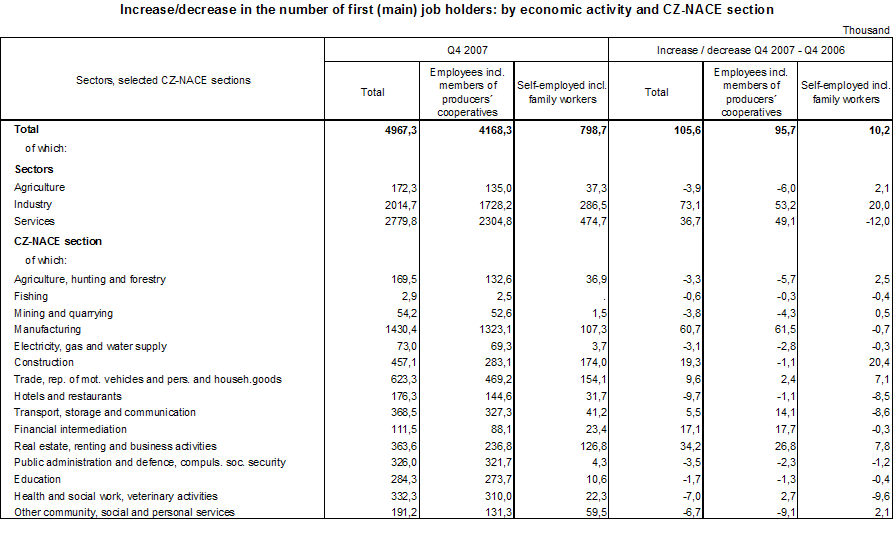
An increase in the total number of self-employed by 10.2 thousand showed itself mainly in the sections ‘construction’ (+20.4 thousand) and ‘real estate, renting and business activities’ (+7.8 thousand). Year-on-year increase in the number of self-employed persons, including family workers was the highest in ‘building completion’ and ‘building installation’. They are own-account workers, i.e. the self-employed without employees. In the section ‘real estate, renting and business activities’ total increase resulted from a higher number of self-employed in ‘legal, accounting, book-keeping and auditing activities; tax consultancy; market research and public opinion polling; business and management consultancy; holdings’ and in ‘real estate activities on a fee or contract basis’. The number of self-employed increased markedly also in ‘wholesale and retail trade; repair of motor vehicles, motorcycles and personal and household goods’, the most in ‘other retail sale of new goods in specialised stores’.
The total employment rate among persons aged 15-64 grew by 0.9 percentage points year-on-year to 66.5%. The relative increase was higher in the employment of men at working age (+1.3 percentage points to 75.5%); female employment was 0.5 percentage points up and reached 57.4%. The employment rate is pushed down by a rapid growth of the number of university students on the one hand; on the other hand, the number of persons in employment is increasing due to the concurrence of employment in the strong birth cohorts from around 1950 and the mid-1970’s and rising retirement age.
Concrete aims for the employment rate in the EU countries until 2010 were determined in the meetings of the European Council in Lisbon in 2000 and Stockholm in 2001. The total employment rate should reach at least 70%, female employment rate at least 60% and elderly employment rate (age group 55-64) at least 50%.
Compared internationally, the Czech Republic is among the countries with the above-the-average employment intensity in the EU. According to the latest complete data for Q2 2007 released by Eurostat, the employment rate of persons aged 15-64 in the Czech Republic was higher than the total for the EU27 but lower than the rate in the EU15. Lower employment rate than in EU15 and EU27 was in the group of women.
Differences in employment rates between EU countries are considerable, not only if we compare the whole age group 15-64, but also in the male and female components of employment. On the one hand there is a high employment rate in the northern countries and the United Kingdom (e.g. in Denmark it was 77.3% in Q2 2007), on the other hand employment rate in many countries was below 60% (in Poland only 56.8% in Q2 2007). Compared to our neighbour states, higher employment rate is in Austria and Germany and significantly lower in Poland and Slovakia. Very low unemployment rate is also in Hungary.
Even bigger differences are in the employment rate of persons aged 55-64. In Malta and Poland it did not even reach 30% and this rate was only closely exceeded by Luxembourg, Slovenia, Slovakia, Italy, Hungary and Belgium. Thus a significant number of member states will have problems with the fulfilment of the Lisbon strategy. Twelve member countries already exceeded the required 50% rate; among them are all the northern and Baltic countries.
Reaching at least 50% employment rate among people aged 55-64 will be complicated for the Czech Republic owing to the low female employment rate. The employment rate of women aged 55-64 is lower than not only the average of the EU15 but also the EU27. It is, however, possible to assume that in the following years this rate is going to rise also as a consequence of adjusting the retirement age.
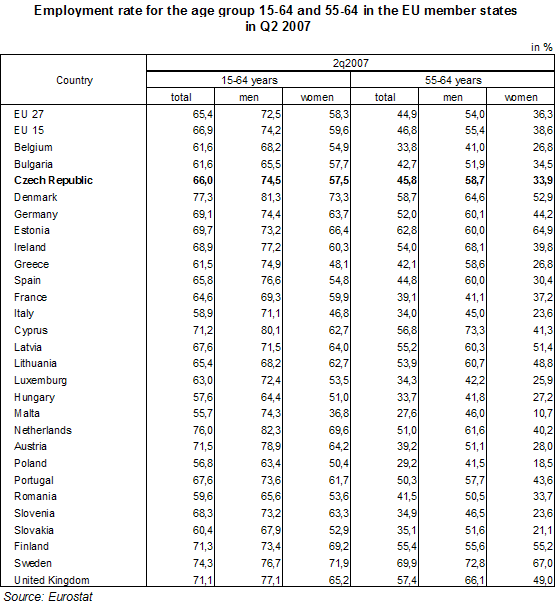
For the Czech economy is typical a high share of secondary sector (industry + construction) employment. This share is the highest among all of the EU27 countries and close to the Czech Republic is only Slovakia. Similarly, in ‘manufacturing’ the share reached 28.6% of total employment in the Czech Republic in Q2 2007. This was the highest figure among all EU states. In the CR, ‘manufacturing’ had by 10 p.p. higher share in total employment than it had in the EU27 and by over 11 p.p. higher than in the EU15. On the other hand, the Czech Republic’s structure of employment by NACE activity is distinguished by a significantly lower proportion of services than in the EU15 (-14 p.p.) and in the EU27 as well (-11 p.p.). In the CR, lower than average employment proportion is mainly in ‘real estate, renting and business activities’, ‘health and social work’, ‘wholesale and retail trade; repair of motor vehicles, motorcycles and personal and household goods’, ‘financial intermediation’ and ‘education’. The following table shows data on the structure of selected EU states in Q2 2007, for which Eurostat published the latest complete results.
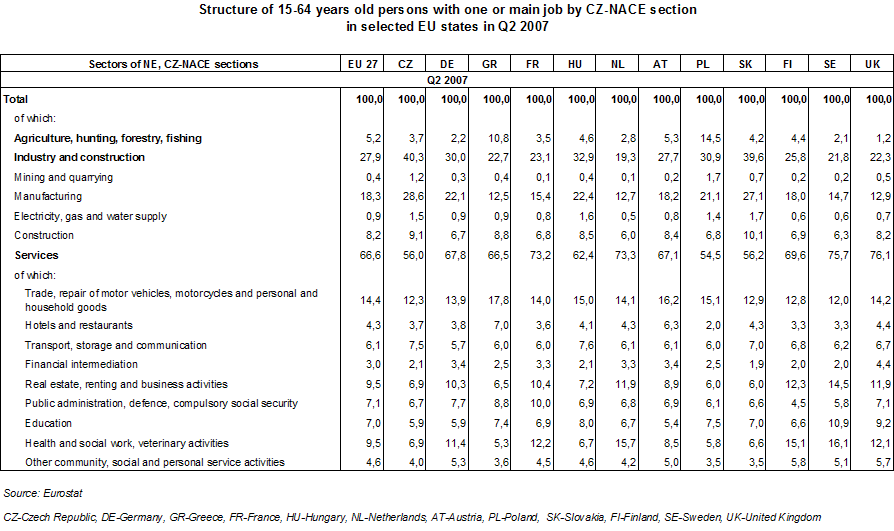
The regional employment in the Czech Republic increased slightly in all the regions; the highest increases were recorded in the Moravskoslezský, Středočeský and Jihomoravský Region. Marked increases were observed also in the Zlínský, Liberecký and Vysočina Region.
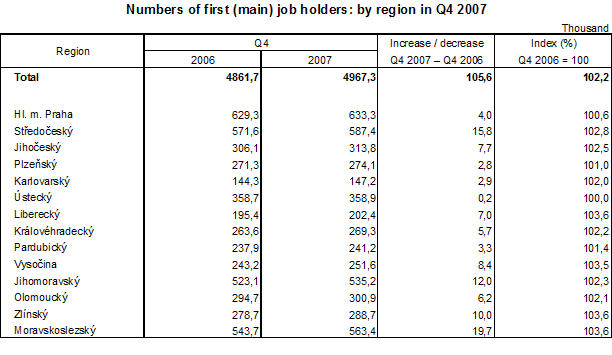
There were 95.0% of persons working full time in their main job in the civil sector of the national economy. Nearly 247.4 thousand persons worked part-time in their main job, most of them were women (181.4 thousand).
The share of persons working full time in their main job is in the Czech Republic the fourth highest among all EU27 member states. Proportion of full-time jobs is higher in Slovakia, Hungary and Bulgaria, the total employment rate is however below the average in all of the three countries. The share of men working full time in the CR was the third highest among the EU27 countries in Q2 2007, women had the fifth highest share.
Especially women appear to have an extraordinary high differentiation of the shares of full-time jobs in employment in individual EU countries. In many countries of the EU15 high number of women uses the opportunity to work part time, particularly in the Netherlands (3/4 of working women aged 15-64 years!) and in the other six countries their share came close or exceeded 40% of the total female employment. The opportunity to work part time is one of the social aspects, which in the long term affects the fertility rate in particular in the Netherlands and in some of the other countries.
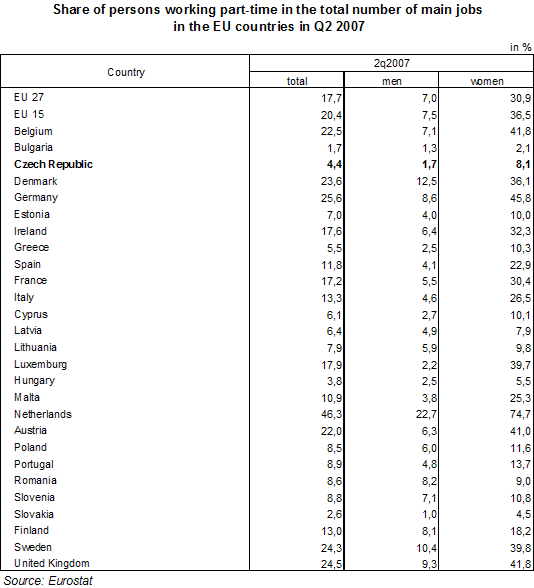
The possibility to work part time enables some countries to raise the retirement age. This holds for Germany, Sweden and the United Kingdom where more than quarter of all persons aged 55-64 work part time; in the Netherlands it was nearly half of all persons at the middle and higher working age.
The number of hours actually worked in the reference week reached 38.3 hours, in full-time employment it was 39.3 hours. The differences in working hours of employees are large, both in terms of their professional status and CZ-NACE activity. The self-employed worked 46.5 hours a week on average, full-time employees 38.0 hours and members of producer cooperatives 35.5 hours. In the long term, these differences are apparent both for men and women when generally men work more hours in all of the professional status categories. The most hours in their main job spent employees in construction (41.8 hours), the least employees in education (34.3 hours).
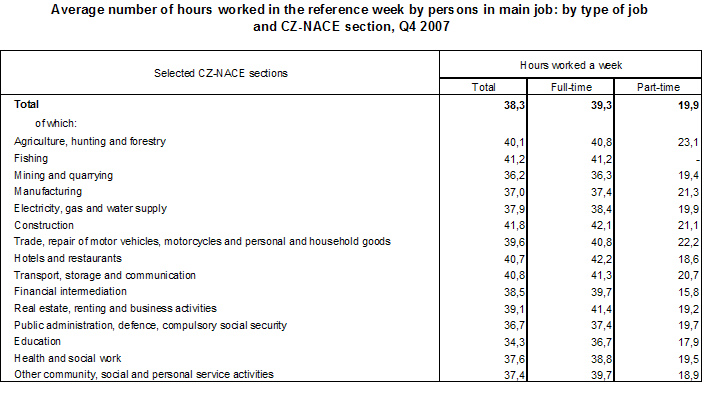
With the growing total employment of the resident population and the economically inactive, the number of the unemployed decreased. The number of unemployed persons (ILO methodology) reached 252.8 thousand on average in Q4 2007, i.e. a fall of 86.5 thousand year-on-year (more than a quarter). The number of the unemployed decreased the most in the age group 20-24 (by 22.1 thousand); and in the age group 50-54 (by 12.2 thousand). The number of unemployed men (109.2 thousand in total) is still below the number of unemployed women (143.6 thousand). Under the total year-on-year drop in unemployment, male unemployment decreased by 44.9 thousand, and the decrease showed itself in the wide age group 15-59. Over the same period, female unemployment decreased by 41.6 thousand in total; it dropped in all of the five-year groups of the working age, except the oldest age group 55-59.
The number of the long-term unemployed (1 year or more) fell by 62.3 thousand in total; drop occurred in all of the age groups of both men and women below 60 years.
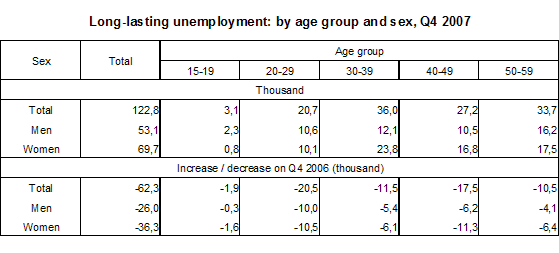
The number of the unemployed with basic education decreased by 15.0% year-on-year to 71.8 thousand, which is connected with a general decrease of the number of Czech residents at working age with the lowest level of education. The number of unemployed persons with secondary education without maturita examination (secondary vocational school graduates in particular) decreased by 30.7% to 108.9 thousand and the number of the unemployed with secondary education with maturita examination decreased by 30.9% to 58.4 thousand. Although the number of unemployed university graduates grew by 2.9% to 13.5 thousand, the unemployment of university graduates is still markedly lower when compared to the first three groups.
Unemployment dropped in all of the regions of the country, most in those with high or above-the-average unemployment rates, i.e. in the Ústecký and Moravskoslezský Region, and also in the Jihomoravský Region.
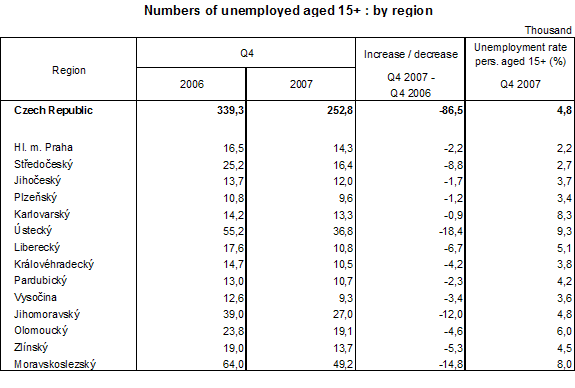
The growth of total employment and the decrease in the number of the unemployed resulted in a relatively high decrease of general unemployment rate of persons aged 15-64 (ILO). In comparison to Q4 2006, the general unemployment rate decreased by 1.7 percentage points to 4.9%. It decreased mainly among the female population (by 1.8 p.p. to 6.3%); the decrease among the male population was 1.6 percentage points to 3.7%. According to the latest data released by Eurostat for Q2 2007, the general unemployment rate in the Czech Republic was markedly lower than in the EU27; besides the relatively low male unemployment rate, also the female unemployment rate in the CR was below the EU27 average. The big decrease of unemployment in the Czech Republic resulted in favourable comparison with the EU27 and the EU15 alike when in Q2 2007 the unemployment rate in the CR was lower than the EU15 average by 1.6 percentage points.
In comparison to the neighbour states, the rate of unemployment in the CR is higher than in Austria but markedly lower than in Slovakia where it is the highest across the European Union and in Poland. Unemployment rate in the CR is noticeably lower also in comparison with Germany mainly due to an unfavourable situation in the long run in the federal states of former East Germany.
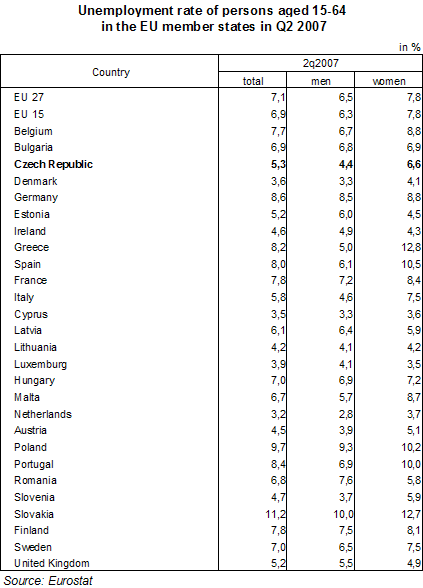
In terms of international comparison, an unfavourable aspect of unemployment in the Czech Republic is persistent high percentage of the long-term unemployed. The proportion of persons out of employment for one year and more in the total number of the unemployed was the fourth highest among all the EU countries in Q2 2007 (54.8% in the CR in comparison to 43.7% in the EU27 and 40.9% in the EU15). The highest proportions of the long-term unemployed were observed, besides Bulgaria, in neighbouring Germany and especially Slovakia where it reached three quarters of all unemployed persons. The high percentage of long-term unemployment in the above countries represents a chronic problem relating not only the elderly unemployed; in the young and middle age group 25-49 the proportion of long-term unemployed persons was the highest within the EU and in the Czech Republic the second highest next to Slovakia.
The number of economically inactive persons aged 15+ (according to the LFSS methodology they are persons who had no job and were not seeking a job during last four weeks or did not meet all conditions for being classified among the unemployed) increased by 62.8 thousand year-on-year and reached 3 657.8 thousand in Q4 2007. This category is primarily affected by numbers of the retired and of persons in schooling or training for their future occupation. The number of basic school pupils decreased by 12.7 thousand; the number of secondary school pupils including vocational school pupils grew by 6.7 thousand to 532.5 thousand. The number of university students including higher professional school students grew by 25.9 thousand to 299.8 thousand. The number of economically inactive normally retired persons not actively seeking job reached 1 932.4 thousand, the number of persons in early retirement 44.8 thousand and the number of disability pensioners 261.3 thousand. These figures cannot accurately correspond to the numbers of pupils and students according to the statistics of the Ministry of Education, Youth and Sports of the CR or to the numbers of pensioners on the records of the Ministry of Labour and Social Affairs of the CR because the pupils, students or pensioners who fulfilled the criterion of being classified among persons in employment or unemployed persons in the reference week are not recorded as economically inactive.
Published: 01.02.2008
The data are valid as of the release date of the publication.
Contact: Information Services Unit - Headquarters, tel.: +420 274 056 789, email: infoservis@czso.cz










